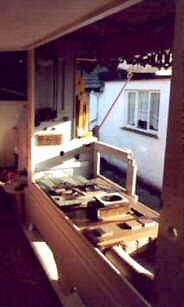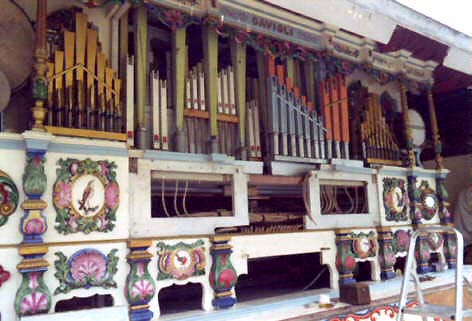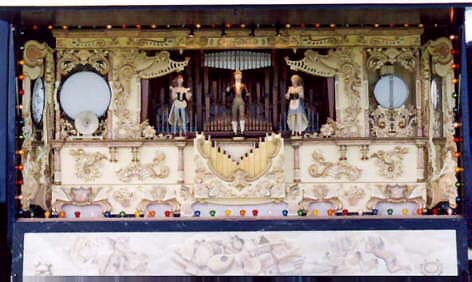




All rights reserved. This document, or any part of it, must not be reproduced in any format without prior written permission of the Fair Organ Preservation Society
©2025 - Fair Organ Preservation Society


The Hills Are Alive With The Sound Of Music (Fair Organ Music, That Is!!)
by William Taylor
Deep in the beautiful mountains of the Lake District, an 89-key Gavioli fair organ known as 'The Lakelander' has recently received a major overhaul. This brings cause for a double celebration as the work was completed just in time for the Organ's 100th birthday. The work has been carried out by organ builder and repairer Peter Griffiths of Hawkshead. Coincidentally, this same organ played a major role in Peter Griffiths becoming involved with the organ world. The Gavioli, which is owned by Ken and Greta Dalton of Penrith, has an interesting history.
Built in Paris in 1897, probably as a G2 instrument, the organ had various showland owners and, at one time, was installed in the centre of the last set of Gallopers built by Thomas Walker of Tewkesbury. These gallopers were delivered new to Mellor's of Nottingham in 1924. The machine survives and is now owned by John Warrington of Yorkshire. This same machine can be seen open daily in the gardens adjacent to Edinburgh's famous Princess Street. Both gallopers and organ ended up at Butlin's Holiday Camp at Filey. It was from Filey that the organ was bought for preservation by the late Zeke Myers in the late 60s. By this time, the organ was completely dilapidated. In a conversation with Mrs Zeke Myers a few years ago, she told me that when the Myers towed the organ home to Cumbria on its trailer they had to follow with a car stopping every so often to pick up parts, pipes, etc, that kept falling off. By the time they got the organ home the car was full of organ bits retrieved from the road.
It was while Zeke was rebuilding the organ that Peter Griffiths, then a schoolboy, got involved. Peter knew the family and went to school with Zeke's sons, Mike and Chris. Peter helped with the work on the Gavioli and the experience led to him building his own 89-key Gavioli style organ which took a number of years. Peter went on to tune and repair many organs for FOPS members and others and he is well known for travelling his own 1923 Duwyn Dutch street organ known as 'The Amsterdam'. (This same organ will bring back memories for older FOPS members when in the ownership of FOPS Officer, Ken Redfern.) Peter also served for a number of years as Secretary of The Mechanical Organ Owners Society.
Getting back to that Gavioli, Zeke Myers, although self-taught on organ work, completely rebuilt the organ and named it 'The Lakelander'. He consequently rallied it extensive throughout England until his death in 1985. The organ continued to attend local events in the capable hands of Mrs Myers and her sons. During this period, Peter was in charge of the organ's upkeep and various work was undertaken, including supplying pipework for and refitting the baritone register which Zeke was working on when he died. Peter also fitted a new primary action rail as well as regular tuning, etc.
| In 1993, the Myers family decided to part with the organ and it was bought by Ken Dalton and his wife who knew the organ well. Once again, Peter Griffiths was commissioned to maintain the instrument and various work was continued, including fitting new rollers and gears to the key frame and installing a new blower but it was obvious there was a serious problem with wind loss. The very hot summer of 1995 brought matters to a head and the organ was booked in for major surgery! At the end of the 1996 rally season, the organ arrived at the Griffiths Organ Works at Outgate, near Hawkshead in Cumbria. |
The old windchest |
|
 The main case was completely stripped out in its entirety where it was found that things
were worse than expected. There was a serious split in the main wind chest (photo above) that could
not be satisfactorily repaired. The only solution was a complete new wind chest, no mean feat
considering that the wind chest in a Gavioli like this one is approximately 8 feet long and 2 feet
wide and built in layers with 90 channels and literally hundreds of holes to be drilled. The
original bellows were still in situ and, although not working to supply air, were being used as a
reservoir. As this was not entirely satisfactory, these were removed and the new purpose built
reservoir was made and fitted. (Photo left) A new action box to feed the pipes under the floor of
the organ was made and the melody and accompaniment pipes under the floor were stripped out,
reglued and the speech on these was reset. Also, the reeds and the baritone reeds were revoiced and
the wind pressure of the full organ was reset. Before the organ re-emerged, the roof of the organ
lorry was insulated.
The main case was completely stripped out in its entirety where it was found that things
were worse than expected. There was a serious split in the main wind chest (photo above) that could
not be satisfactorily repaired. The only solution was a complete new wind chest, no mean feat
considering that the wind chest in a Gavioli like this one is approximately 8 feet long and 2 feet
wide and built in layers with 90 channels and literally hundreds of holes to be drilled. The
original bellows were still in situ and, although not working to supply air, were being used as a
reservoir. As this was not entirely satisfactory, these were removed and the new purpose built
reservoir was made and fitted. (Photo left) A new action box to feed the pipes under the floor of
the organ was made and the melody and accompaniment pipes under the floor were stripped out,
reglued and the speech on these was reset. Also, the reeds and the baritone reeds were revoiced and
the wind pressure of the full organ was reset. Before the organ re-emerged, the roof of the organ
lorry was insulated.
With the work now completed, the organ was opened up outside the organ works and put through its paces. The mountains echoed with organ music which could be clearly heard as far away as Hawkshead Village which is over a mile away. This organ has a particularly fine and extensive repertoire of organ books which can now once again be heard playing at their best. Congratulations to organ man Peter Griffiths and organ owners, Mr & Mrs Ken Dalton. Look out for the 89-key Gavioli Organ, 'The Lakelander,' at rallies throughout the north of England.
|
The organ almost completely reassembled; baritone section, glockenspiel and figures still to be fitted. |
Article Copyright © William Taylor, 1997
Originally published in edition 3 of The Key Frame 1997.
Letter in edition 4, 1997, from Eddie Hayward:
|
|
Further to KF-1997-3 and, in particular, the article by William Taylor, I thought it may be of interest to pass on some information in that respect. The article refers to Peter Griffiths building an 89-key Gavioli style organ, which I now own and which was fully rebuilt and modified by Tim Blythe in 1993. For interest I attach a photograph of the organ as it now is. (Left) |
Letter Copyright © Eddie Hayward, 1997
Originally published in edition 4 of The Key Frame 1997.



